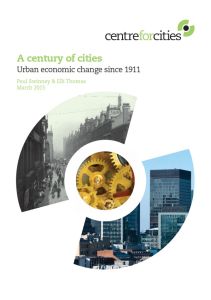Acesse a sua conta getAbstract para obter o resumo!

Acesse a sua conta getAbstract para obter o resumo!
Paul Swinney and Elli Thomas
A Century of Cities
Urban Economic Change Since 1911
Centre for Cities, 2015
Sobre o que é?
Explore the economic policies that contributed to the United Kingdom’s “North-South divide.”
Recommendation
Paul Swinney and Elli Thomas of the UK-based research and policy institute Center for Cities explore the changing world of work in major cities across the UK since 1911. They highlight the gap between the northern and southern regions of the country, and explore reasons why the South is faring better than the North in the job market. This well-researched report traces the history of several cities, discusses changes in the nature of work and suggests measures the UK government can adopt in order to bridge the gap between the two regions. getAbstract recommends its findings to economists, policy makers and industrialists.
Summary
About the Authors
Paul Swinney is a senior economist and Elli Thomas is a researcher at Center for Cities, a UK-based research and policy institute dedicated to improving the economic success of cities in the UK.


















Comment on this summary